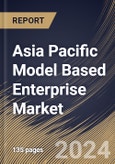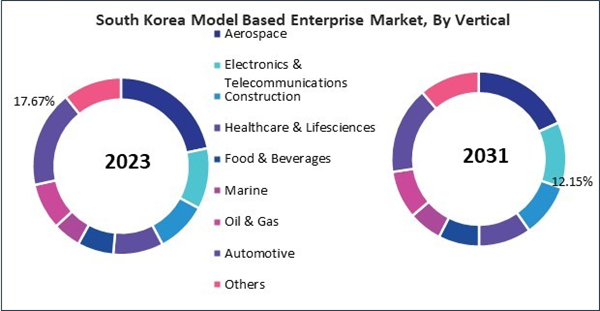The Asia Pacific Model Based Enterprise Market would witness market growth of 15.3% CAGR during the forecast period (2024-2031).
The China market dominated the Asia Pacific Model Based Enterprise Market by Country in 2023, and would continue to be a dominant market till 2031; thereby, achieving a market value of $2,778.9 million by 2031. The Japan market is registering a CAGR of 14.5% during (2024 - 2031). Additionally, The India market would showcase a CAGR of 16% during (2024 - 2031).
The model based enterprise market serves various end-use industries, from manufacturing to healthcare to construction. For example, the aerospace and defense industry is one of the primary users of MBE solutions. MBE enables aerospace manufacturers to design, simulate, and manufacture complex aircraft components and systems more efficiently. It facilitates collaboration among multidisciplinary teams, streamlines supply chain management, and supports regulatory compliance.
MBE is also used in the healthcare industry for medical device design, surgical planning, and personalized medicine applications. MBE enables healthcare organizations to create patient-specific models, simulate medical procedures, and optimize treatment plans. By leveraging digital models, healthcare professionals can improve patient outcomes, reduce risks, and enhance the efficiency of medical interventions.
India has become one of the biggest automobile manufacturers in the world, producing a wide range of vehicles shipped worldwide. The growth of the automotive industry in India drives demand for MBE solutions that can streamline design, engineering, and manufacturing processes. India is the world’s third-largest automobile industry. The industry produced 25.93 Mn vehicles, including passenger vehicles, commercial vehicles, three-wheelers, two-wheelers, and quadricycles, from Apr 2022 to Mar 2023. The automobile sector accounted for 5.35% of the total FDI inflow. Likewise, with rapid urbanization and infrastructure development across China, there is a growing emphasis on sustainable and technology-driven construction practices. Approximately 27 trillion yuan ($ 4.2 trillion) will be invested overall in new infrastructure during the 14th Five-Year Plan period (2021-2025). The revised plan asks for constructing over 50 million square meters of net zero energy buildings and retrofitting over 350 million square meters of existing buildings. Thus, the growing infrastructure projects and expansion of the automotive industry are propelling the market’s growth.
Based on Offering, the market is segmented into Solution and Services. Based on Deployment Mode, the market is segmented into On-premise and Cloud. Based on Vertical, the market is segmented into Aerospace, Electronics & Telecommunications, Construction, Healthcare & Lifesciences, Food & Beverages, Marine, Oil & Gas, Automotive and Others. Based on countries, the market is segmented into China, Japan, India, South Korea, Australia, Malaysia, and Rest of Asia Pacific.
The China market dominated the Asia Pacific Model Based Enterprise Market by Country in 2023, and would continue to be a dominant market till 2031; thereby, achieving a market value of $2,778.9 million by 2031. The Japan market is registering a CAGR of 14.5% during (2024 - 2031). Additionally, The India market would showcase a CAGR of 16% during (2024 - 2031).
The model based enterprise market serves various end-use industries, from manufacturing to healthcare to construction. For example, the aerospace and defense industry is one of the primary users of MBE solutions. MBE enables aerospace manufacturers to design, simulate, and manufacture complex aircraft components and systems more efficiently. It facilitates collaboration among multidisciplinary teams, streamlines supply chain management, and supports regulatory compliance.
MBE is also used in the healthcare industry for medical device design, surgical planning, and personalized medicine applications. MBE enables healthcare organizations to create patient-specific models, simulate medical procedures, and optimize treatment plans. By leveraging digital models, healthcare professionals can improve patient outcomes, reduce risks, and enhance the efficiency of medical interventions.
India has become one of the biggest automobile manufacturers in the world, producing a wide range of vehicles shipped worldwide. The growth of the automotive industry in India drives demand for MBE solutions that can streamline design, engineering, and manufacturing processes. India is the world’s third-largest automobile industry. The industry produced 25.93 Mn vehicles, including passenger vehicles, commercial vehicles, three-wheelers, two-wheelers, and quadricycles, from Apr 2022 to Mar 2023. The automobile sector accounted for 5.35% of the total FDI inflow. Likewise, with rapid urbanization and infrastructure development across China, there is a growing emphasis on sustainable and technology-driven construction practices. Approximately 27 trillion yuan ($ 4.2 trillion) will be invested overall in new infrastructure during the 14th Five-Year Plan period (2021-2025). The revised plan asks for constructing over 50 million square meters of net zero energy buildings and retrofitting over 350 million square meters of existing buildings. Thus, the growing infrastructure projects and expansion of the automotive industry are propelling the market’s growth.
Based on Offering, the market is segmented into Solution and Services. Based on Deployment Mode, the market is segmented into On-premise and Cloud. Based on Vertical, the market is segmented into Aerospace, Electronics & Telecommunications, Construction, Healthcare & Lifesciences, Food & Beverages, Marine, Oil & Gas, Automotive and Others. Based on countries, the market is segmented into China, Japan, India, South Korea, Australia, Malaysia, and Rest of Asia Pacific.
List of Key Companies Profiled
- Siemens AG
- PTC, Inc.
- Dassault Systemes SE
- SAP SE
- HCL Technologies Ltd. (HCL Enterprises)
- Oracle Corporation
- Wipro Limited
- ANSYS, Inc.
- General Electric Company
- Cisco Systems, Inc.
Market Report Segmentation
By Offering- Solution
- Services
- On-premise
- Cloud
- Aerospace
- Electronics & Telecommunications
- Construction
- Healthcare & Lifesciences
- Food & Beverages
- Marine
- Oil & Gas
- Automotive
- Others
- China
- Japan
- India
- South Korea
- Singapore
- Malaysia
- Rest of Asia Pacific
Table of Contents
Chapter 1. Market Scope & Methodology
Chapter 2. Market at a Glance
Chapter 3. Market Overview
Chapter 4. Competition Analysis- Global
Chapter 5. Asia Pacific Model Based Enterprise Market by Offering
Chapter 6. Asia Pacific Model Based Enterprise Market by Deployment Mode
Chapter 7. Asia Pacific Model Based Enterprise Market by Vertical
Chapter 8. Asia Pacific Model Based Enterprise Market by Country
Chapter 9. Company Profiles
Companies Mentioned
- Siemens AG
- PTC, Inc.
- Dassault Systemes SE
- SAP SE
- HCL Technologies Ltd. (HCL Enterprises)
- Oracle Corporation
- Wipro Limited
- ANSYS, Inc.
- General Electric Company
- Cisco Systems, Inc.
Methodology

LOADING...









